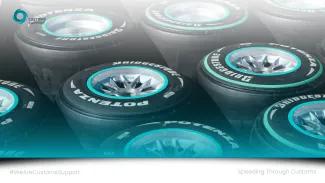With races sometimes a week apart, logistics teams need to be as well-oiled as the cars to keep things moving. A single piece of equipment can be the difference in a race, with winning and losing sometimes coming down to milliseconds on the final lap.
This is why there are often five or six sets of duplicate equipment moving at the same time. Teams need guarantees that their equipment will be there for the events. But with all the high-speed chaos of transporting Formula 1 around the world, how are all the goods moved through customs? Find out in this article.
Formula 1 commodity codes
A lot of equipment moves with Formula 1. As well as the cars, the parts, and the other mechanical equipment that is needed for the race, there is also a variety of non-race-related goods.For example:
- Branded merchandise for sale.
- Exercise equipment.
- Marquees, tables, and chairs.
- Kitchenware.
- First aid supplies.
With the huge variety of equipment that can be inside a single container, declarations to customs can be 100s of items long. It is essential that every commodity code is correctly declared, as a single query can delay the container at the border.
If there are too many queries made against a trader, they may find that future shipments are automatically delayed for inspection. This is something that Formula 1 teams cannot risk, so they might use the following strategies to reduce the risk for error:
- Keeping the packing list the same for non-consumable goods (like chairs and tables).
- Partnering with a digital customs clearance agent to remove manual entry.
- Utilise customs consultants to ensure that their classification is correct.
You can read more about the risks of using incorrect HS codes here.
Correct customs procedures for the different types of movements
Once the complexity of selecting HS codes has been navigated, Formula 1 shipments need to be declared for the correct use. Customs procedures vary for different countries, but there are three categories that most of the goods will be in:
Temporary imports
Goods that will leave the country after the race, such as the car, mechanical equipment, and chairs, will be declared as temporary imports.
Declaring goods as a temporary import allows an organisation like Formula 1 to suspend duty and VAT, or make it refundable. For race cars entering Europe, the full Duty and VAT are paid as a security to customs, which is refunded once the cars are exported.
Standard imports
These are the goods that have a commercial value, that will definitely be exhausted in the country. For example, race-specific merchandise like an Irish flag branded “Formula 1 Wexford 2025”. These goods will not be reexported, so full duty and VAT is applicable.
ATA carnet – combining the two
Countries that participate in the Admission Temporaire or Temporary Admission (ATA) carnet scheme allow goods for shows and exhibitions to be temporarily imported for use at the show without paying for Duty and VAT.
An ATA carnet is a separate document that is required for the movement that suspends the taxes by holding the owner accountable, similar to a T1 transit form.
Once the ATA carnet is issued, it is valid for one year. You cannot amend the period of validity or the goods covered once issued; you must get an additional ATA carnet.
Duty and VAT are then paid on any goods that are not re-exported from a country that is visited. This prevents goods that are for commercial sale, like seasonal merchandise, from being taxed in multiple countries.
Customs Support are here for your large-scale supply chain customs requirements
With 1,700+ agents in 13 countries across Europe, our team has processed nearly every type of declaration. Supported by our customs consulting services and leading EDI technology, we provide end-to-end digital customs clearance that keeps your supply chain simple and compliant.
If you could benefit from a partnership that supports your entire operation in Europe, contact us for more information on how we can help you today.














